

|

|

|

|

|

|

|

|

|
What
Radios - Antenna - Equipment
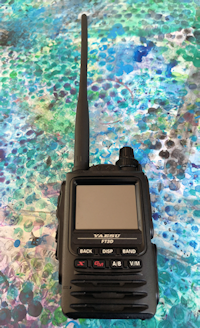
A new HT in 2021
I started with an old radio borrowed from my ham club, and I've been operating with a low-budget HT for a few years since then, and I was finally ready to make a more significant investment in radio equipment. After much (very enjoyable) research online and talking with other hams, I finally settled on the newest Yaesu HT, the FT3D.I am so glad I did! I'm delighted with my new 'toy', even if it did take me a while to get it programmed, it's a far different beast than the relatively simple Baofeng, it's a super-trick bit of kit, very high tech with loads features I don't actually understand (yet)!
I will be learning it's features, modes and functions for quite a while, which is money well spent in terms of learning opportunities. Wires-X and several other (insert adjective here, I'm not even sure how best to describe them) are on my list to figure out, and I also need to reacquaint myself with APRS, which I've used before, but on a different radio, and not recently.
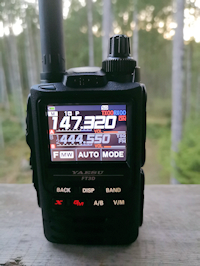
My first HT! 2014
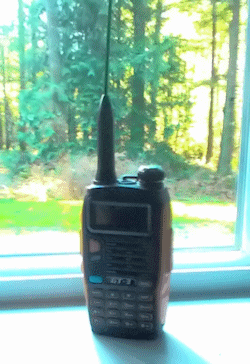 Since I got my license in 2012, I've been fortunate to be able to operate several different radios borrowed from the Salt Spring Island Amateur Radio club. It's been an excellent opportunity to find out what I find useful, what sort of operating I enjoy, what features I might like to have in a radio of my own. I finally took the plunge late in 2014 and purchased a Baofeng GT-3 handheld dual band radio. Far more buttons than the TAD, but a bit more user friendly for a computer nerd, since it comes with a cable I can connect to a computer via a nice familiar usb connector. So far I actually haven't had much success getting my radio and computer to acknowledge each other, but I have figured out how to program the radio by hand.
Since I got my license in 2012, I've been fortunate to be able to operate several different radios borrowed from the Salt Spring Island Amateur Radio club. It's been an excellent opportunity to find out what I find useful, what sort of operating I enjoy, what features I might like to have in a radio of my own. I finally took the plunge late in 2014 and purchased a Baofeng GT-3 handheld dual band radio. Far more buttons than the TAD, but a bit more user friendly for a computer nerd, since it comes with a cable I can connect to a computer via a nice familiar usb connector. So far I actually haven't had much success getting my radio and computer to acknowledge each other, but I have figured out how to program the radio by hand.
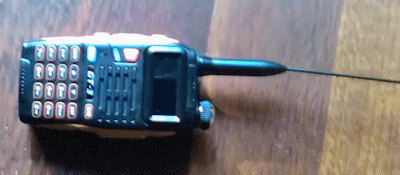
My first HAM radio! 2012
The Salt Spring Amateur Radio Club has been kind enough to loan me a 2 meter mobile radio, a TAD M8-1540, which I gather dates from the early to mid-1980's. I think it's an excellent radio to start on the air with, basic operation seems simple, and there are some user programmable features I can experiment with when I've read a bit more about it.
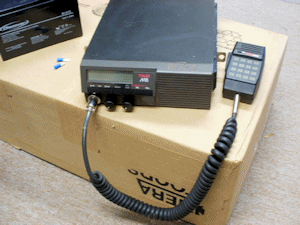
|
|
TAD M8 Radio makes a great 'beginner rig' for a new ham - a few simple controls make operation much less intimidating for a newbie to get on the air.
|
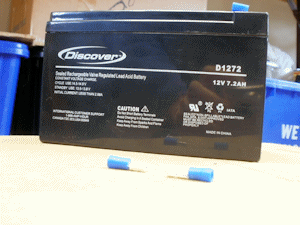
|
|
The first thing I had to work out was a power source. Since I'm interested in emergency communications, a battery based power source seemed like my best choice, but I didn't want to be hauling a 130lb. marine battery around, so I found smaller options. This is my BIG battery!
|

|
|
This side of the radio presented me with a few more complications. The antenna part was easy, but the original electrical connectors had to be modified to connect with my 12 volt battery power source, and the connectors I found weren't a good fit with the battery terminals. Thanks to VE7SJW and VE7DVB for helping me solve my connector challenges!
|
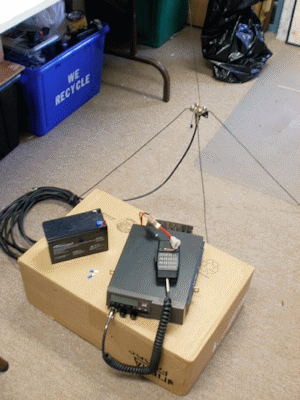 My first antenna! VE7SJW built this antenna for my radio, and it works great; thanks Wilf!
My first antenna! VE7SJW built this antenna for my radio, and it works great; thanks Wilf!It does faintly resemble a coat hanger impersonating a star-fish, but the fact that I can send and receive radio with it makes it simply amazing.
While it's not exactly hand-held-portable, my entire rig can be easily relocated - the radio, battery, spare battery, battery charger, all their assorted cables and connectors fit in a box I can lug under one arm while I brandish my antenna in my free hand... would you call that semi-mobile? (ungainly-but-portable?).
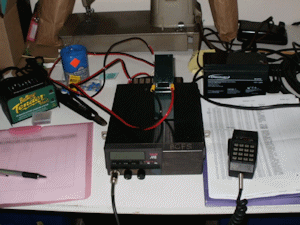 The whole station, radio, battery and spare battery, charger - even my log book and frequency/channel cheat sheet. I don't normally keep the battery on top of the radio, I just moved it there to squish it all into the photo, and to give some scale on the small battery (isn't it cute?). I haven't yet figured out how much operating time I can get out of the little battery, but I can run off it for a week of daily/occasional use.
The whole station, radio, battery and spare battery, charger - even my log book and frequency/channel cheat sheet. I don't normally keep the battery on top of the radio, I just moved it there to squish it all into the photo, and to give some scale on the small battery (isn't it cute?). I haven't yet figured out how much operating time I can get out of the little battery, but I can run off it for a week of daily/occasional use.I realize it's not a very elegant set up yet, but it works great, and eventually I'll build it a shelf, or case, or box... depending on how much I end up moving it around, a box of some sort might make it more mobile.
Eventually I'll know more about what I want in a radio, get my own; then the club can pass this one on to the next graduating class of new hams. Getting on the air can seem like a big (and confusing) investment for a new HAM, and I really appreciate the opportunity to learn a bit more about radio first - thanks SSIARC!
MORE TAD M8-1540 Information
Operating Instructions
TAD-M8 User Programming SHORT Instructions 1 Page PDF File (66 kb)TAD-M8 User Programming DETAILED Instructions 4 Page PDF File (41 kb)
Service Manual
Link to download the AWA (Amalgamated Wireless Australia) Service Manual for the TAD M8-1540 (from the '80's)http://www.eserviceinfo.com/downloadsm/38988/AWA_M8-1540.html
Company Website
TAD Radio Canada http://www.tadradio.com/
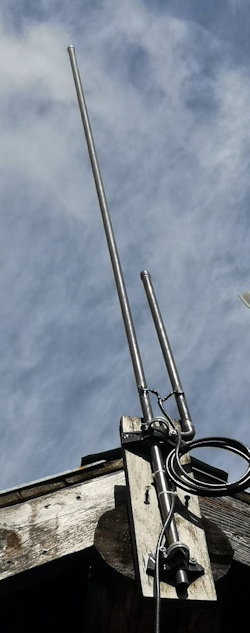
Antenna
I've discovered I'm quite keen on antenna building, although many of the complexities of antenna tuning are still a mystery to me, I like soldering projects, and often making an antenna involves soldering.So far I've build a copper plumbing J-Pole and a PVC & Measuring Tape Yagi... not adventurous designs but lots of fun to build. I have also discovered that antenna bees are a great social event, and I really like working on projects with other people.
The J-Pole pictured to the right is the one I built at the SSIARC Antenna Bee... that was a fun day I remember fondly, and I have this lovely (now developing an attractive patina of age) VHF J-pole.
I've also discovered the joys of metal roofs where I'm living now, but that's another story.
I'm deciding what VHF antenna to build next, if you have a novel plan, attractive compact design or a favourite pattern, please let me know?
More Equipment!
Oscillator - My first 'home brew'
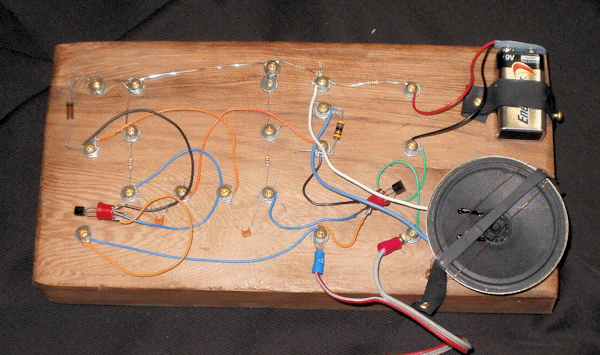
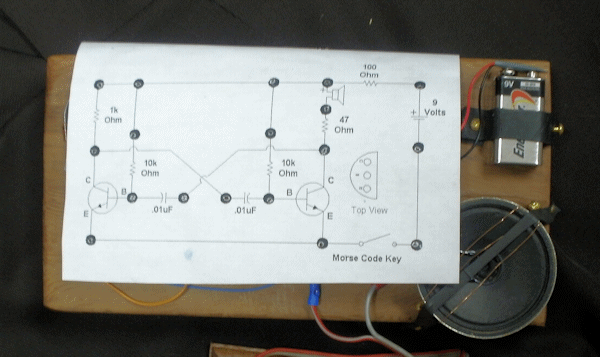

Interested in trying this project?
You can find the ARRL's instructional PDF file here: http://www.arrl.org/files/file/ETP/A%2520One%2520Hour%2520No%2520Solder%2520CPO%2520ver%25202_2.pdfI'm still working hard to master morse code, but my brain is very reluctant... I am definately not an auditory learner, and I'm having to be very patient with my brain.
I read somewhere that it took Samuel Morse 8 years to reach a speed of 10 WPM, and that's made it easier to be patient with my learning process; I can give myself a few years to work on it...
Thanks for visiting... hope to meet you on the air! 73
~ Andrea VA7ALG